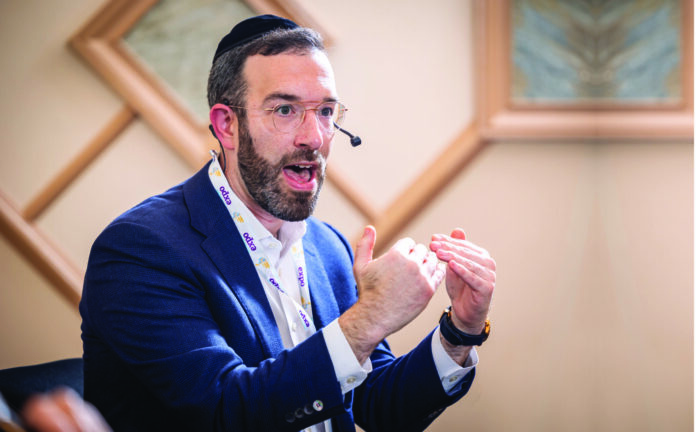Focus—or more accurately, the lack thereof—keeps coming up in my conversations with the entrepreneurs featured in Lunchbreak. So many of us struggle with staying focused in our technologically driven, distracted world. How can one be more present and productive? It never ceases to be a hot topic.
Recently, I spoke at several conferences, and many of the attendees told me that these questions resonate with them because they too struggle with fighting off distractions. It seems that we are all seeking ways to combat phone addiction and become laser-focused to get things done.
Many people associate a lack of focus and ability to concentrate with having ADHD, which is often the case. Many adults who have ADHD weren’t diagnosed as children or opt not to seek help as adults. This can be for a variety of reasons; not wanting to seem vulnerable is a common one.
Enter Dovid Becker, LCSW, ADHD-CCSP, a recognized expert on ADHD.
I recently moderated a panel at the Providers Expo in Boro Park. I was looking for a panelist who not only understands the mental health field but also teaches others, and I was introduced to Dovid by noted therapist and educator Dr. Akiva Perlman. Dovid agreed to join the panel, and we also spent many additional hours in conversation both before and after the event.
Dovid runs a private practice in Lakewood and is the director of the men’s program at the Sara Schenirer Institute, in partnership with the Wurzweiler School of Social Work. Much of Dovid’s practice focuses on adults with ADHD. In fact, this interview was conducted before, during and after he delivered a presentation on relationships at a prestigious international ADHD convention in Dallas.
I was amazed at the depth of Dovid’s understanding of the struggles of the ADHD mind in general, as well as the difficulties entrepreneurs with ADHD face on a daily basis. On a personal level, as someone who counts himself among those who struggle to focus, I found that his advice rang true. While a single article can never take the place of therapy, mentoring or coaching, I hope that our conversation will lead the reader to better understanding, coping and healing. Although the focal point of our talk was how ADHD impacts people in the workplace, the takeaways are relevant for everyone.
—Nesanel
“I was born and raised in Brooklyn. I went to Tiferes Elimelech for elementary school, Mir for high school and Torah Vodaas for beis midrash. Then I went to learn in the Mir in Eretz Yisrael under Rav Yosef Elefant, whom I consider my rebbe. I was there for three years and then went to BMG for the next seven years or so.
“My first ‘job’ was setting up the video equipment for Rav Yisroel Reisman’s weekly navi shiur. At the first one, there were only seven attendees, including me. I was six years old. Eventually, the shiur moved to Achiezer, and as it grew, I helped set up the video hookup downstairs. Running up and down the steps adjusting the wires was a great way to keep myself busy during the shiur.
“In 2004, I started working as a head counselor for Camp Yachad in Lakewood. It was an amazing experience. I ended up spending a lot of time working on it during the year as well. Ten years ago, we opened a girls’ division called Neranina. Baruch Hashem, we were able to put together an amazingly creative and talented team, and it has become one of the largest girls’ day camps in Lakewood.
“One day, I was sitting in BMG when I felt a tap on my shoulder: ‘Rabbi Kotler wants to speak to you.’ They were starting a new program called Talmudo B’Yado, which would help bachurim and yungeleit write and publish chiddushei Torah. I had no idea how to write, but someone had recommended me for the job, probably because of my managerial experience. We ended up helping thousands of people, and the program is still growing.
“When I was 30 years old, I decided to become a social worker. Running the camp wasn’t a full-time position, and I wanted to do something that would enable me to help people. In camp, I often served as a kind of therapist, so I thought I’d be successful at social work. I had no grandiose ideas. I just thought I’d enjoy it, and off I went to a frum men’s social work program. After graduation, I interned at the Lakewood Community Services Corporation, an outpatient clinic, for two years and then worked full time for another five years. Eventually, in 2015, I opened a private practice. Basically, I went to Home Depot, bought a shingle and hung it up. Not literally, of course, but I rented an office and started seeing people. It helped that I had a camp because people knew me and were comfortable sending referrals my way.
“My wife’s aunt works for Sara Schenirer, and she recommended me for a job teaching in their social work program, which runs in partnership with the Wurzweiler School of Social Work. I absolutely love teaching there; the students are bright, passionate and eager to learn. I feel fortunate to play a small part in helping the next generation of therapists train in a hashkafically appropriate environment. Being part of a team of highly skilled frum leaders has also had an enormous impact on both my clinical work and personal development. A few years later, I became the director of the men’s program.
“I started off working with kids struggling with anxiety, oppositional behavior and OCD. Children have a lot of worries and fears. Some of the fears that came up frequently were about robbers, illness or death. With kids suffering from OCD, there would be issues like repeating the words in davening or checking locks. These days, most of my work is with teens and adults.
“I was trained in cognitive behavioral therapy. You get to see the healing process with CBT: someone comes with a fear and he gets better. The therapeutic process is incredibly powerful and rewarding, but it can be really slow. Evidence-based interventions like CBT are goal focused, and can help more quickly with clients for whom this is appropriate. One way that this model can be helpful is with developing a toolbox to manage emotions. Over time, I trained in several more modalities and began to incorporate those into my work as well.
“I’ll give you an example. I worked with a boy who was so terrified of thunderstorms that he would call the weather hotline all day long to find out if there was rain in the forecast. If it was going to rain, he wouldn’t go to yeshivah. It got to a point where he was calling every three minutes. I helped him understand how his brain works, that it was sending him false alarms and exaggerating the level of risk. We did some exposure therapy to thunderstorms in a slow, gradual process: reading about them, watching videos of storms, going out in the rain. We did it one step at a time until he was able to handle a storm.





















